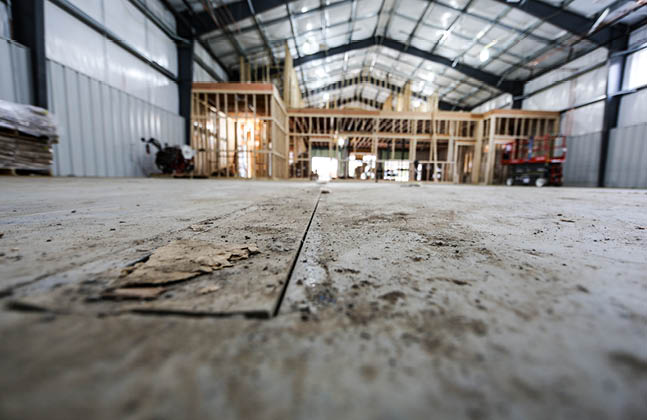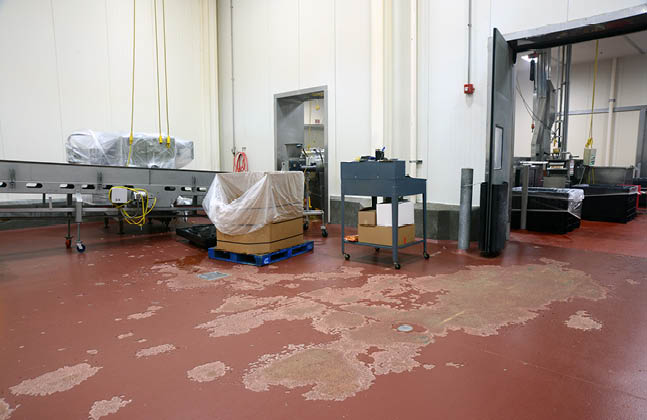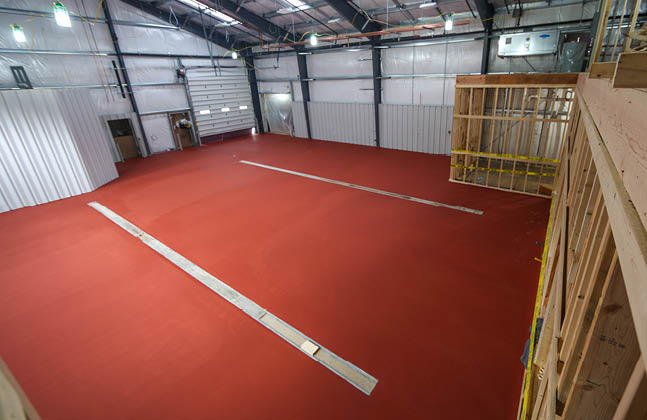A critical step in a successful industrial flooring installation is the expert preparation of the substrate surface for the application of the flooring system. The hazards of an improperly prepared concrete surface can manifest almost immediately after installation, but preparing a surface with the right profile can help to ensure an effective bond of the coatings to the substrate, extending a floor’s strength, durability and appearance. Surface preparation can save time and money as well as substantially reducing the possibility of coating failure and costly re-works.

The substrate in an industrial facility that’s in need of preparation!
There are various factors involved in determining the right surface preparation treatment for the durability of a floor. Factors that can affect the preparation treatment per area include temperature, moisture level, traffic, as well as the current condition of the substrate. Further considerations include the current state of any coatings, and whether cracks, dust, rust, mould or similar imperfections are present.
Identifying imperfections
Imperfections in the substrate can come in all shapes and sizes, from dust to damp, and loose coatings to laitance. Removing these contaminants allows for full exposure and evaluation of the substrate, making it easier to identify long-term issues that could affect the integrity of the flooring.
If these imperfections are not removed, then flooring failure and mass delamination can occur, resulting in costly repairs and an increased workload.
Bond Failure at the Substrate
Bond failure at the substrate occurs when the coating or flooring system delaminates at the bond line, which leads to the finish being easily removable from the substrate. This can be identified through peels, chips or separation in the floor coatings. These chips or cracks can be a trip hazard, as well as being epicentres for dirt, dust and bacteria.

Prarieland Foods Before: We can see that a substantial amount of the coating has chipped away from the substrate
Causes of this failure could be due to inadequate shot blasting of the substrate, presence of water, oil, grease or dust, improper curing of the resin coating, or other obstacles such as the presence of previous coatings or sealers.
Preventing Bond Failure
The foundation of any coating or flooring system is surface preparation. The purpose of surface preparation is to create a surface profile that will promote mechanical adhesion by removing all contaminants.

Flooring such as this polyurethane coating require effective surface preparation or they risk failure
Preparing the substrate
Adding a coating to a damaged substrate can cause mirroring of irregularities through the floor coverings, ruining the appearance and performance of the finished floor. Using a suitable water or solvent-based primer prior to applying the coatings can help to prevent this bond failure.
Diamond grinding, scarification or enclosed shot blasting is appropriate surface preparation for concrete. These methods clean the substrate and create an open textured profile that the resin coating can adhere to. When choosing materials, deciding on those with improved abrasion and chemical resistance, and specifying the correct thickness of coating can help to further prevent sub-floor damage in the future.
As well as providing an excellent profile for floor coatings, surface preparation is also important for stabilisation and improved transitions between different flooring products. A solid foundation is necessary to meet health and safety standards and outstanding quality of flooring.

Prarieland Foods After: Smooth and safe flooring without chips or cracks
Check back in with us next week where we go into the specifics of different techniques for preparing the substrate.





